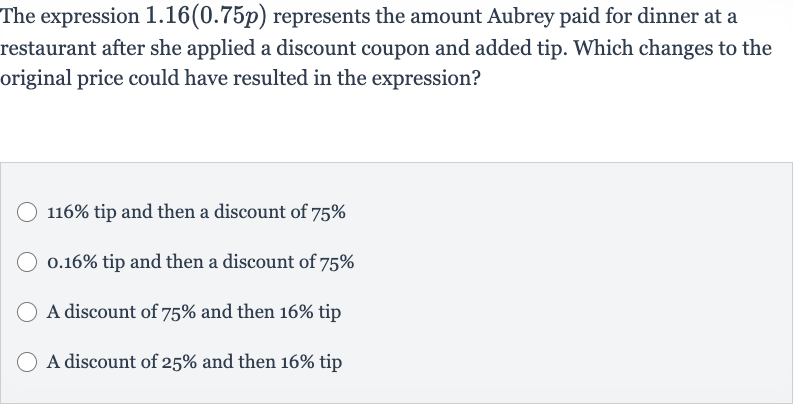AI tutor
Welcome to Bytelearn!
Let’s check out your problem:

The expression represents the amount Aubrey paid for dinner at a restaurant after she applied a discount coupon and added tip. Which changes to the original price could have resulted in the expression? tip and then a discount of tip and then a discount of A discount of and then tipA discount of and then tip
Full solution
Q. The expression represents the amount Aubrey paid for dinner at a restaurant after she applied a discount coupon and added tip. Which changes to the original price could have resulted in the expression? tip and then a discount of tip and then a discount of A discount of and then tipA discount of and then tip
- Understand the expression: Understand the expression . This expression represents two consecutive changes to the original price . The first change is represented by , which suggests a reduction to of the original price, indicating a discount. The second change is represented by multiplying the discounted price by , which suggests adding a tip to the discounted price.
- Analyze first option: Analyze the first option, "% tip and then a discount of %." This would mean applying a tip on the original price and then reducing the resulting amount by . The expression for this would be , which simplifies to . This is not the same as the given expression .
- Analyze second option: Analyze the second option, " tip and then a discount of ." This would mean applying a tip on the original price and then reducing the resulting amount by . The expression for this would be , which simplifies to . This is not the same as the given expression .
- Analyze third option: Analyze the third option, "A discount of % and then % tip." This would mean reducing the original price by and then adding a tip to the discounted price. The expression for this would be , which simplifies to . This matches the given expression.
- Analyze fourth option: Analyze the fourth option, "A discount of and then tip." This would mean reducing the original price by (making it of the original price) and then adding a tip to the discounted price. The expression for this would be , which simplifies to . This also matches the given expression.
More problems from Interpret regression lines
QuestionGet tutor help
QuestionGet tutor help
QuestionGet tutor help
QuestionGet tutor help
QuestionGet tutor help
QuestionGet tutor help
QuestionGet tutor help
QuestionGet tutor help
QuestionGet tutor help
QuestionGet tutor help
